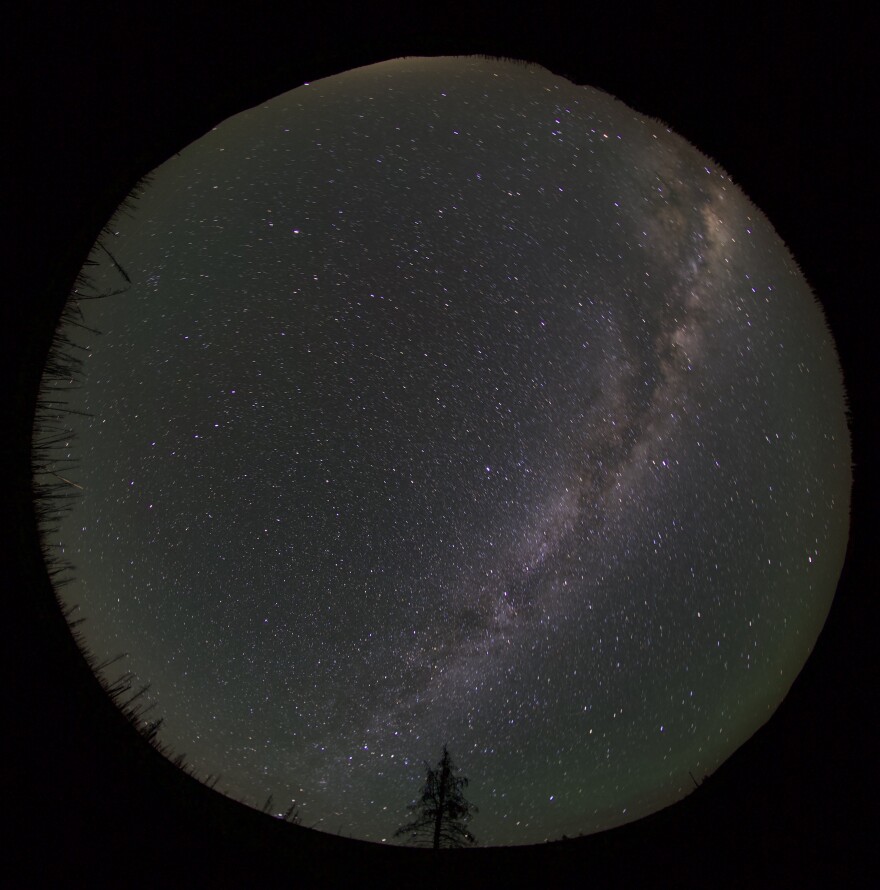This story is part of a series called "After Dark." Find other stories in the series here.
Jules de la Cruz was studying environmental science at UCLA when she got an assignment to go to Idaho as a “light pollution ambassador.”
She arrived with one other student, Mahliya Purificacion. Together, they got ready for their first mission.
"It's like 11 p.m. We pack this suitcase — it looks like a suitcase from 'Deal or No Deal' — it's pretty heavy duty."
Inside, it had a tripod and camera. They put the bag in the trunk of their Toyota Corolla rental, bundled in warm clothing and ventured down the backroads.
Their task was simple: take unobstructed pictures of the night sky.
"The overarching goal is to get the images," de la Cruz said. "At least one image, at the very least."
They were stationed in the Central Idaho Dark Sky Reserve, which spans about 1,400 square miles between Ketchum and Stanley. It became the country’s first reserve of its kind in 2017. It’s so dark, you can reportedly see shadows cast from the planet Venus.
Local ordinances ensure minimal impact from city lights on the dark skies. But growing metropolitan areas, even outside the reserve, have the potential to threaten its gold-tier status.
In 2021, Boise State University received a $1 million grant from NASA to increase educational outreach and citizen science efforts surrounding the Dark Sky Reserve.
Last summer, the program allowed an "astronomer-in-residence" to visit the Stanley area. It also led to the partnership with Professor Travis Longcore at UCLA, which brought Purificacion and de la Cruz to the reserve as NASA "light pollution ambassadors" to study the sources of light pollution seeping in.
The first night in Idaho, the pair arrived at their first destination and made sure to park a distance away, so the recent glow from their headlights would be out of sight. They hiked up to a spot with a view, and set up their special "sky quality camera" with a fisheye lens and a setting for long-exposure shots.
"You have to make sure that one side of the camera is facing North," de la Cruz explained.
They calibrated the camera with a compass on their phones. Then, for a couple of minutes, they waited for the camera to take the image.
They stayed out until early in the morning. But this time, their photos didn’t come out very well because it was cloudy.
For de la Cruz, the anticipation of seeing the dark night skies had been building since before she arrived in Idaho.
"I grew up in LA, so having a bunch of lights at night, and having like six different street lights on at 2 a.m., was normal for me," she said.
Most people in this country – more than 80% – live in places where light pollution means they can’t see the true night sky.
Though de la Cruz had stared at numerous high-quality photographs of the Milky Way through her work studying light pollution in a UCLA lab, she was eager to know what it would feel like to stand under it herself.
"That was kind of one of the selling points of preserving the night sky," she said. "There is the ecology aspect of it, the health aspect, but I think one of the biggest sellers is just the beauty of it."
The first night might have been a letdown, but the pair planned a two-night expedition near Stanley in one of the more rural places in the reserve.
Their photography destination one of the evenings was an open field surrounded by a forest, where de la Cruz said they had an almost 360-degree-view of the sky. They set up the camera, pressed the shutter and looked up.
"You just see this bright twinkling and it's dark, but it's not empty," she said. "Just being there in this silence and this darkness, but then being surrounded in the top by this blanket of twinkling stars, I mean, it seems, I don't know, warm, cozy, just — I don't know if the word is ethereal, but definitely magical to a certain extent."
When the shutter closed a couple of minutes later de la Cruz looked at the back of the camera and saw what the device could see, which she could not — a brightness she couldn’t make out with her own eyes. The wide-angle lens transformed the 3-D scene into a flattened snow globe.
Seeing this "ideal" picture — a navy background, the bright band of the Milky Way and speckles of stars — helped her understand the kind of light that was not supposed to be in the frame.
The leaders of the Dark Sky Reserve had been concerned about how growth in Idaho’s capital city could be affecting the night sky in one of the most remote places in the state.
De la Cruz said she could see a glow from Boise in some of the images — a yellow-green haze that surrounds the edges.
The UCLA students and Longcore will start analyzing these fisheye photos early next year. The software they use erases the stars and the Milky Way so that it can focus on the unnatural light along the horizon.
That will help them pinpoint sources of light pollution. More photos taken year after year can show potential trends. That’s why de la Cruz is coming back next summer.
Though she said the skyglow of LA is normal for her at this point, and even symbolizes the comfort of a place she loves, she said doing research in the reserve showed her how rare moments of true darkness can be. And she’s excited to bring some more "light pollution ambassadors" along.
Find reporter Rachel Cohen on Twitter @racheld_cohen
Copyright 2022 Boise State Public Radio
Copyright 2022 Boise State Public Radio News




